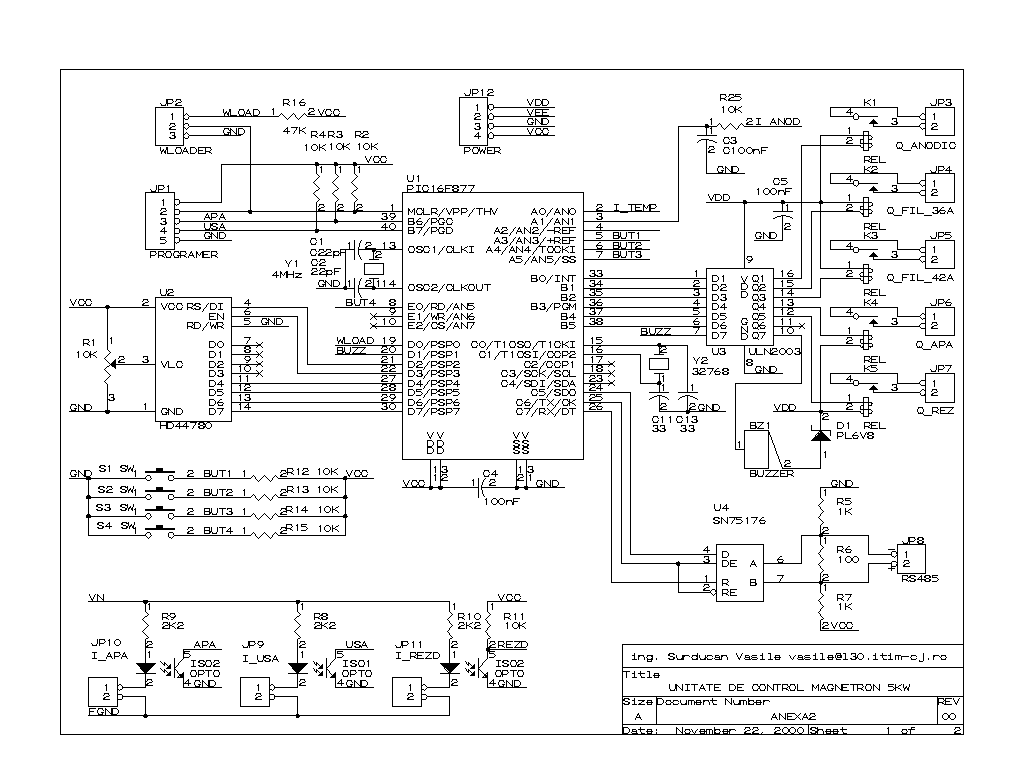e = e’ - ie’’eff (1)
where: - e’ is the real part
of the permittivity, which characterize the amount of microwave reactive
power changed with material (without absorption);
- e’’eff is the imaginary
part of the permittivity, which characterize the microwave global absorption’s
in the material.
The permittivity is a function of the material temperature and of the
microwave frequency. In the general case, the permittivity is a tensor
which depends on the homogeneity and anisotropy of the materials. The microwave
power absorbed in the material, assuming that all microwave power is transformed
in warmth, is (equation 2):
f - microwave frequency,
Ei - microwave E field in "i" point;
Ki - coupling coefficient for "i" point ;
Fi - filling factor;
ei - absorber mixture relative permittivity in point "i";
eo - free space permittivity;
vi - is the local volume in "i " point;
Any microwave oven is a multimodal microwave cavity in which the incident power ( usual 700W to 70KW at 2.45 GHz ) has a particular distribution . If the probe to be treated has a great volume ( like drying foods in foodstuff industry or ceramic materials microwave drier ), this multimodal cavity is suitable for a treatment because many parts of the local power distribution are intersecting the probe volume. The user must have a total control for the microwave radiation like: modifying continuously the output power in a large range ( not only the output energy used in almost all home-appliance ovens ) and controlling precisely the treatment period.
We present here, briefly, our design concerning a 5KW magnetron oven with an effective volume of 1 cubic meter, based on continuous wave CK 101 magnetron and driven by a flash microcontroller PIC16F877.
2.The concept
In fig.1 is shown the typical structure for our high power microwave
oven:
Fig.1 Typical high power structure of a microwave oven - click on figure to enlarge
The magnetron ( microwave power generator ) is supplied through an anodic transformer ( T1-6KV/1A ) and a two steps filament transformer ( T2-7.5V/42A and 5.5V/36A ). The magnetic field of the magnetron is produced in two coils ( L1 supplied from a PWM based constant current source, with max.10A and 20V voltage swing and L2 supplied by a feedback anodic current ). All supplying algorithm are supervised by microcontroller board (4) with a simple interface user (6) consisting in four functional buttons ( the same buttons have different functions displayed on the second line of the LCD as the program flow chart required) and a large LCD display. Because the high anodic temperature ( 150 C ), a cooling system ( with cold water and air flow ) is required. Both the water flow command and air flow presence are supervised by the microcontroller board using an anodic temperature measurement. All other parameters like door status ( open or closed ), cooling water pressure, treatment period and output microwave power are also under microcontroller control.
3. The firmware
The firmware is a software translated into a hex code by a compiler
[3] or an assembler and stored in microcontroller’s [1] memory by a programming
sequence, assisted by the PC and by a hardware programmer [5] board. A
bootloader [2] will allow fast low voltage programming as many time as
the firmware development is requiring. For our oven, there are 14 different
LCD screens, ( the starting screen and the buttons are presented in fig.2
) distributed in four working modes of the oven’s brain:

Fig.2 – The starting screen
a programming mode (fig.3 )in which the user can specify the output power and the treatment period:


Fig.3 – Programming mode screens
a treatment mode where some specific information are displayed, like treatment time in progress, microwave output power and current status ( on – shut on the microwave radiation inside the oven, by initiating first a 3 minutes filament heating procedure and a priority test door status and cooling parameters of the magnetron; standby - the user may open the door unit and change the probe while the magnetron filament is still heated but anodic current is shutdown, off – the current process is finished and the magnetron filament is also shutdown ),


Fig.4 – The ON screen ( treatment mode ) Fig.5 – The measuring screen ( treatment mode)
a measuring mode where the user may check some important plant parameters like magnetron anodic current and temperature ( measuring mode is active only from inside of treatment mode), and an abnormal ending mode ,

Fig.6 – Error screen ( door open in treatment mode )
for extremely situation, like door open when treatment is in progress ( situation with maximum priority considering operator biological protection, solved using microcontroller interrupts), anod temperature exceeded, anod current out of limits or low water pressure.
4.The microcontroller board design
A simple configuration with PIC16F877 microcontroller ( fig.7), running
at 4MHz clock speed and 32768 Hz real time clock was chosen. Hd44780 display
( U2 ) is connected using nibble mode transfer on PORT_D. Two "in circuit
programming" connectors are used , one for HVP ( JP1) and another for bootloader
LVP ( JP2). All inputs and outputs to plant are isolated using optocouplers
or relays driven by a specialized driver ( U3 ), except the analogic inputs
which are measuring voltage signals near ground. The temperature sensor
measuring the anodic temperature and the sense resistor which convert the
anodic current into voltage are carefully configured to avoid noise interference
and high voltage leackage. A PWM signal from CCP1 filtered with a RC network
is used for reference to generate the magnetization constant current

Fig.7 Microcontroller board schematic- click
on figure to enlarge
for magnetron coil. A piezo-buzzer is also used to mark all important events with user interface ( pressing buttons or signalizing the process end ). A RS-485 or an optional RS-232 interface will be provided for long distance measurements and programming.
5.Conclusions:


